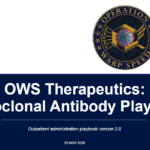
This playbook is intended to support sites interested in administering COVID-19 treatment under EUA including:
• Existing hospital or community-based infusion centers
• Existing clinical space (e.g. urgent care, emergency depts)
• Ad hoc new infusion sites (e.g. “hospitals without walls”)
• Long-term care facilities or home infusions with infusion delivery capability

